 |
 |
 |
 |
 |
 |
 |
|
 |
|
  |
|
|
|
 |
 |
| Genesis'
sample collection area, the Lagrange 1 point, is named
for the Italian-French Mathematician Joseph-Louis Lagrange.
In 1764, he authored an essay for the Paris Academy of
Sciences, defining points between bodies in space where
the gravity is balanced between them. The position of
the L1 point is stable enough to allow Genesis to orbit
it, with assistance from small thrusters on the spacecraft.
The L1 point afforded Genesis an uninterrupted view of
the Sun. The spacecraft arrived there in November 16,
2001.
Genesis occupied what scientists call a "halo"
orbit, meaning that it orbits around an empty point
in space, not a physical object. The spacecraft's orbit
was not completely circular. Viewed from the side, so
that the Sun, spacecraft and Earth appear to be in a
straight line in the plane in which the planets orbit,
the halo orbit leans slightly toward the Sun. Looking
down on the orbit, so that the north pole of Earth and
Sun and the top of the spacecraft are visible, the orbit
looks elongated.
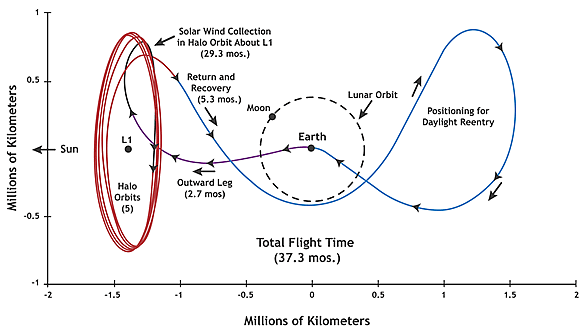 |
Genesis Mission Trajectory and Flight Plan
|
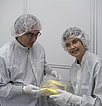 |
Project Manager,
Don Sweetnam and Genesis Curator,
Judy Allton at
Johnson Space
Center |
The spacecraft's science instruments worked together
to categorize and sample the solar wind. The collection
period concluded on April 1, 2004. Three weeks later,
Genesis executed the first of five thruster firings
sending it on a trajectory that will eventually place
its sample return capsule in Earth's upper atmosphere
on Sept. 8. As if the return of NASA's first space sample
mission since Apollo 17 were not dramatic enough, the
technique in which the sample return capsule will be
captured adds to the mission's distinctiveness. As the
capsule parachutes toward the ground at the U.S. Air
Force's Utah Testing and Training Range, two three-person
crews flying specially outfitted helicopters will capture
the capsule in mid-air to prevent the delicate samples
from being disturbed by even the slight impact of a
parachute landing.
Once on the ground, the samples were taken to NASA's
Johnson Space Center, Houston, Texas, where the collector
materials have been stored and maintained under extremely
clean conditions to preserve their purity for scientific
study throughout the century.
In March 2005, Johnson Space Center curatorial staff
started allocating solar-wind collectors to the international
scientific community. Sample analysis and related cosmochemical
and solar research will continue for decades.
|
|
|
|
| |
Date |
|
Event |
| |
8/8/2001 |
|
Launch |
| |
11/16/2001 |
|
Halo Orbit Insertion
|
| |
12/3/2001 |
|
Start of Sample Collection |
| |
4/2/2004 |
|
Completion of Sample Collection |
| |
5/2/2004 |
|
Earth "Flyby" on way
to L2 |
| |
9/8/2004 |
|
Sample Return Capsule (SRC) returns to Earth |
| |
9/15/2004 |
|
Solar Wind
shipped
to Johnson Space Center (JSC).
The SRC shipped separately to Denver |
| |
10/4/2004 |
|
The Utah Testing and Training Range-packaged collectors
flown to JSC |
| |
9/2004
– 9/2008 |
|
Sample Cataloging at JSC |
| |
3/2005 |
|
Distribution of Solar Wind Particles to
the International Scientific Community |
|
|
|
Genesis was launched Aug.
8, 2001, at 12:13:40 p.m. EDT from Florida's Cape Canaveral
Air Force Station. The launch vehicle was a Delta II
model 7326 rocket, similar to Deltas that have launched
other recent solar system exploration missions. These
rockets have differed primarily in the number of solid-fuel
boosters that augment the first stage of the liquid-fuel
Delta.
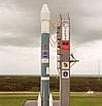 |
 |
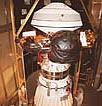 |
Genesis spacecraft prepares for launch |
|
Genesis spacecraft in fairing of Boeing Delta rocket at Kennedy Space Center days before launch |
|
|
|
The cruise phase was
the period of travel 1.5 million kilometers (930,000
miles) from Earth to the Lagrange 1 point that lasted
slightly over three months. The main activities during
cruise included check-out and monitoring of the spacecraft
and science instruments, and navigation activities necessary
to determine and correct Genesis' flight path. |
|
|
Genesis
entered orbit around the L1 point on Nov. 16, 2001.
At arrival, the spacecraft's large thrusters fired to
put it into an elliptical, or looping, orbit around
the L1 point. Genesis completed five orbits around L1;
nearly 80 percent of the mission's total time was spent
collecting ions from the Sun. Learn more.
|
|
|
Genesis opened
its collector arrays and began accepting particles of
solar wind on Dec. 3, 2001. A total of 850 days were
logged exposing the special collector arrays to the
solar wind. These collector arrays are circular trays
composed of palm-sized hexagonal tiles made of various
high-purity materials such as silicon, sapphire, gold
and diamond-like carbon.
After the sample return capsule opened, the lid of the
science canister opened as well, exposing a collector
for the bulk solar wind. As long as the science canister's
lid was opened, this bulk collector array was exposed
to different types of solar wind that whistled past
the spacecraft.
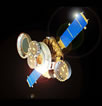
|
Artist rendering of Genesis spacecraft during collection
phase of mission
|
|
Genesis' ion and electron monitors,
located on the equipment deck outside the science canister
and sample return capsule, monitored changes in the
solar wind. The monitors relayed information about these
changes to the main spacecraft computer, which in turn
commanded the collector arrays to change to expose the
appropriate collector.
The monitors distinguished between three types of solar
wind — fast, slow and coronal mass ejections —
by recognizing the wind's characteristic temperature,
velocity, density and composition. There were three
collector arrays that folded out, and each was extended
when a certain type of solar wind passed by.
Genesis' other dedicated science instrument, the solar
wind concentrator, was designed to do exactly as its
name implies, concentrate the solar wind onto a set
of small collector tiles made of diamond, silicon carbide
and diamond-like carbon. The concentrator was exposed
to the solar wind throughout the collection period,
as long as the lid of the science canister was opened.
That collection of pristine particles of the Sun came
to an end on April 1, 2004, when the Genesis team ordered
the spacecraft's collectors stowed. The closeout process
was completed on April 2, when Genesis closed and sealed
the spacecraft's sample return capsule. The capsule
will remain sealed until NASA technicians open it in
a temporary clean-room facility at Dugway, Utah. The
canister will then be removed and transported to NASA's
Johnson Space Center, where the materials it contains
will be removed in a state-of-the art clean room installed
specifically for Genesis.
|
|
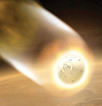 |
Artist rendering of capsule reentry |
On April 22, 2004, Genesis began
its journey back toward its home planet. This was initiated
by the first of five planned thruster firings during
the mission's return phase designed to fine-tune the
spacecraft's flight path for Earth return.
Because of the position of the landing site —
the U.S. Air Force's Utah Testing & Training Range
— and the unique geometry of Genesis' flight path,
the spacecraft could not make a direct approach and
still make a daytime landing. In order to allow the
Genesis helicopter crews an opportunity to capture the
return capsule in daylight, Genesis mission navigators
designed an orbital detour toward another Lagrange point,
L2, located on the other side of Earth from the Sun.
After completing one loop around this point in space,
the spacecraft will be set up for a daytime return to
Earth on Sept. 8. |
|
|
For planning purposes,
the Genesis team refers to the final 30 days of flight
— from Aug. 9 to Sept. 8, 2004 — as the
recovery phase of the mission. The location of the landing
footprint for the Genesis capsule will be predicted
by tracking the spacecraft before the capsule's release.
Since the capsule does not have a propulsion system,
there is no way to abort the entry sequence following
its release.
|
Entry Phase of Genesis Capsule |
|
Artist rendering of capsule being released from spacecraft
|
|
Mission navigators targeted the capsule to hit a "keyhole"
at the top of Earth's atmosphere at an altitude of 125
kilometers (410,000 feet) on September 8 at 9:55 a.m.
Mountain Daylight Time (MDT). This elliptical-shaped
keyhole 33 kilometers (20.5 miles) long and 10 kilometers
(6.2 miles) wide is over the Pacific Ocean. If the capsule
entered the atmosphere anywhere inside this keyhole,
it will come down over the designated spot on the Utah
Test & Training Range.
At about 2 a.m. MDT Sept. 8, the
Genesis team conducted one final teleconference to discuss
the status of the spacecraft's trajectory. After receiving
a "go," they radioed the spacecraft to start
executing a series of commands to release the sample
return capsule.
|
|
|
Throughout the recovery
phase, the Genesis team would closely evaluate the spacecraft's
re-entry trajectory. If at any point navigators and
mission planners felt the spacecraft and/or its sample
return capsule would not achieve required entry targeting
specifications, they can go to “plan B”
— a backup orbit. Navigators have designed a secondary
plan that would place the spacecraft and its capsule
in a six-month backup orbit around Earth. If required,
the maneuver to place the spacecraft and the sample
return capsule in this temporary orbit would take place
at entry minus 3.5 hours.
This backup orbit allows for a secondary entry opportunity
to take place at the same location over the Utah Test
& Training Range on March 17, 2005, at 2:40 p.m.
MDT.
|
|
|
At 9:55 a.m. MDT,
the capsule entered Earth's atmosphere at a velocity
of approximately 11.04 kilometers per second (24,706
miles per hour). The only human-made object to re-enter
Earth's atmosphere at a higher speed was the Apollo
10 command module, which hit 11.11 kilometers per second
(24,861 mph). When it entered the atmosphere, the Genesis
capsule was over northern Oregon. The capsule stabilized
with its nose down because of the location of its center
of gravity, its spin rate and its aerodynamic shape.
In an optimal situation, forty-five
seconds after entry, the capsule will be exposed to
a deceleration force three times the force of Earth
gravity, or 3 G's. This arms a timer that is started
when the deceleration force passes back down through
3 G's. All of the parachute releases are initiated from
this timer. Sixty seconds after entry, at an altitude
of 60 kilometers (197,000 feet), the exterior temperature
of the heat shield will peak at about 2,500 C (4,500
F). Slightly over 10 seconds later, the capsule will
be exposed to about 30 G's, the greatest deceleration
it will endure during Earth entry. During this time
period, the capsule's heat shield will lose an estimated
3 kilograms (about 7 pounds), or about 6 percent of
its weight, as a small amount of the ablative material
erodes away with the heat generated during entry through
the atmosphere.
At 127 seconds into entry at an
altitude of about 33 kilometers (108,000 feet), a mortar
aboard the capsule will fire, releasing the 2.03-meter-diameter
(6.7-foot) drogue parachute to provide stability to
the capsule until the main chute is released. The capsule's
heat shield will rapidly cool during this subsonic portion
of the descent.
Four minutes and fifteen seconds
later, at an altitude of 6,700 meters (22,000 feet),
three pyrotechnic bolts will release the drogue chute
from the capsule. As the drogue chute moves away, it
will extract the capsule's main chute, a 10.5- by 3.1-meter
(34.6- by 12.1-foot) parafoil. Full inflation of the
parafoil will occur in about 6 seconds. Once inflation
is complete, the parafoil and its payload will begin
a slow, loose spiral descent through the skies of the
Utah Test & Training Range.
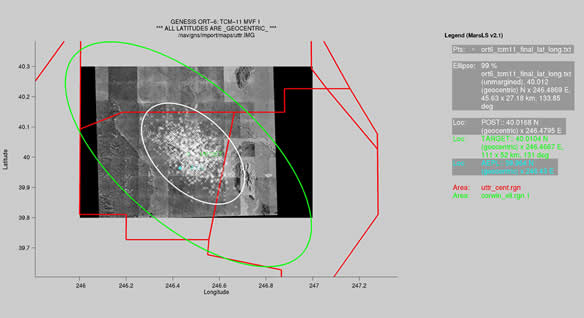 |
Genesis landing pre-return footprint and projected landing targets
|
Mishap
Investigation Board Report
The landing footprint for the sample
return capsule is an ellipse that takes in most of the
Utah Test & Training Range, except for some areas
that have a high population density. The footprint is
an ample area to allow for aerodynamic uncertainties
and winds that might affect the direction the capsule
travels during its descent.
|
|
|
As the Genesis
capsule descends through the atmosphere, it will be
"painted" by powerful radars located on the
Utah Test & Training Range. This will provide tracking
information allowing ground-based cameras to spot the
capsule. Backup tracking is provided by a Global Positioning
System (GPS) unit on the Genesis capsule that transmits
position data to a ground station, which in turn relays
the information to the mission control center. The radar,
visual and GPS data will provide an accurate plot in
three dimensions for the capsule's location. This plot
is generated at the mission control center located about
160 kilometers (100 miles) away from the range at Hill
Air Force Base. A ground control intercept officer based
at the Hill Air Force Base mission control will direct
helicopter flight crews towards the capsule.
|
Artist rendering
of Vertigo helicopter
lining up to
snap parafoil |
|
Descending at about 3.7 meters per
second (12 feet per second, or slightly over 8 miles
per hour), it will take about 10 minutes for the capsule
to descend after its parafoil deploys until it reaches
the 3,000-meter (10,000-foot) altitude inhabited by
the two chase helicopters. By this time, the two flight
crews will have been hovering for about 10 minutes when
they receive the information on the capsule's location.
Each helicopter has the capability of making a successful
intercept anywhere on the Utah Test & Training Range.
When the primary flight crew "tally-ho's"
(visually spots) the Genesis capsule, they will take
over the intercept, flying into position behind the
parafoil. The crew will lower the capture pole and its
hook to about a 50-degree angle as they fly in a trailing
formation and observe the parafoil's flight characteristics.
If all looks well, they will accelerate so as to overtake
the parafoil at a closing speed of about 7 to 10 meters
per second (15 to 20 miles per hour). The pilot will
skim the top of the capsule's parafoil with only about
2.5 meters (8 feet) separating the helicopter's landing
skids and the top of the parafoil.
As the parafoil strikes the boom,
its fabric will wrap around the pole and slide down
its length into the hook. When the hook encounters 200
pounds of force, the hook will separate from the boom
activating a piston that secures the parafoil to the
hook. The hook and its out-of-this-world catch will
remain connected to the helicopter via a 137-meter (450-foot)
Kevlar cable. The helicopter pilot will then pitch the
ship's nose up, quickly decelerating to prevent the
possibility that the parafoil will re-inflate and cause
mischief with the flight characteristics of the helicopter.
If the approach does not look satisfactory, the lead
flight crew can wave off. From the anticipated 2.75-kilometer
(9,000-foot) altitude for a first capture attempt, there
will be an estimated five additional opportunities to
perform a successful mid-air retrieval. |
|
|
After snagging the re-entering capsule, the helicopter pilot was to have transported the suspended capsule directly to the cleanroom and gently lower the capsule into a cradle near the entrance. There, the ground team would then roll the cradle into the building, open the outer capsule inside the cleanroom and start purging the science canister with pure nitrogen. After stabilizing the canister, it was to be shipped unopened back to johnson Space center where it could be opened and the collectors removed for preliminary assessment under extreme clean conditions.
The Genesis spacecraft returned to Earth on September 8, 2004, experiencing a non-nominal reentry in which both the drogue and main parachutes failed to deploy causing the capsule to impact the surface of the UTTR desert at a speed of 193 miles per hour. The impact caused severe damage to the capsule and a breach of the science canister in the field. The spacecraft was located on its side with about 50% of the capsule below the soil surface and the drogue mortar and pyrotechnic devices undeployed. The science canister was recovered and returned to the cleanroom at UTTR within approximately 8 hours of reentry. Although the ground water table did not rise to canister level before removal, damp soil and debris from the heat shield and other spacecraft components did enter the canister and contaminate collector surfaces.
Goals of the Intermediate Recovery Team:
To meet the objective of the preliminary assessment plan, the following goals have been set forth:
- Provide a complete inventory of collector materials available for scientific study. This includes: collector type, dimensions, notes on as-received condition, drawings, and photographs.
- Provide traceability of collector fragments to their parent arrays, and where possible their flight location within that array.
- Provide data on contamination levels, including particulate exposure and molecular contamination.
- Provide detailed description of damage induced by physical abrasion, chemical reaction or other relevant processes.
Condition of the Collectors:
|
Concentrator target post-landing |
|
Concentrator Targets: The concentrator targets were recovered nearly intact and with little visible contamination beyond fine dust. The only fragmented material was the diamond on silicon quadrant, of which more than 85% was recovered in four large fragments, ranging from ~ 5 mm x 5 mm to one half of the quadrant. Much of the remainder was recovered as smaller pieces. Thus the assessment and subdivision of the targets will proceed much as in the nominal case with the possible exception of dust removal. Since the targets were inverted during science collection, the effects of on orbit outgassing should be minimal. Dust removal and the potential evaluation of molecular contamination will be addressed below.
Gold Foil Collector: Like the concentrator targets, the gold foil collector was recovered in remarkable condition. The material is intact and compromised only by minor wrinkling of the surface. No tears were noted, although two micrometeroid impacts were observed in one corner of the sample. These should not interfere with the early science plan to allocate half of the foil for nitrogen isotope analysis. (Obviously, the half without the impacts is preferable for allocation.) This again, is quite similar to the nominal case. No direct evidence of molecular contamination was observed, though again, dust may be present. Evaluation of both of these issues is addressed in this document.
|
Collector Array in cleanroom at UTTR hours after recovery |
|
Aluminum Collector: The polished aluminum collector was located on the impact side of the spacecraft and sustained physical damage not observed in the concentrator targets or gold foil collector. The piece is bent or curled on some edges and the overall flatness is superimposed with a wave-like ripple. The surface, in many respects, remains highly polished but there is surface scratching and more direct contact with UTTR soil in the bulk form of mud, rather than simply dust. Clearly, some additional assessment of surface cleaning may need to take place. In addition, darkening of the aluminum thermal shield supporting the aluminum collector was observed. This “browning” is observed to trace the outline of the aluminum collector though it is not clearly observed on the collector surface itself. The source of this discoloration is unclear and possibilities include: long term hydrogen exposure of the anodized material and/or outgassing and subsequent UV degradation of contaminants from other sources on the spacecraft. An approach to assessing these observations and their indications for subsequent processing of the aluminum collector are addressed in this plan.
Bulk Metallic Glass Collector: The bulk metallic glass collector was retrieved intact from the top of the canister array deployment mechanism. It was removed by extracting the three attach screws. The collector surface shows little evidence of scratching or molecular deposition, but both will be evaluated in addition to dust removal options.
|
 |
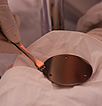 |
Metallic glass before removal from capsule |
|
Metallic glass after removal from capsule |
Array Collectors: The array collectors were the most seriously effected and compromised by the hard landing and canister breach. Nearly all of the collectors shattered to a greater or lesser extent. Collector survival was directly correlated to: position on the arrays with respect to shear and impact and collector identity or more precisely crystal lattice and orientation. Sapphire based collectors, for example, which have no continuous crystal cleavage plane, had superior survival rates to silicon and germanium, both of which have clean cleavage planes along their (100) orientation. (All of the silicon and germanium collectors were oriented in the (100) direction because these materials have greater purity and lower defect concentrations than other orientations.) Materials on the outer edges of the arrays, away from the shear plane, also had higher survival rate.
|
Silicon on sapphire hexagon wafer found intact after impact |
|
Although one complete hexagon and several half hexagons were retrieved from the canister, the majority of the collectors were broken into multiple fragments (many < 5 mm x 5 mm). A limited number of these fragments remained attached to the array frame and thus could be identified unambiguously. Because the majority of the pieces were not attached at any point and as a result of the force, shear and orientation of the impact, significant collector fragment mixing between arrays occurred. Every effort was made to identify and record the found location of collector fragments, however, the majority of the pieces will need to be evaluated for thickness to unambiguously identify their parent array. This process is discussed below.
|
Cataloged pieces of lid foil recovered from impact site |
|
Capsule Lid Foil Collectors: The Lid Foil collectors were a dedicated PI experiment and as such were recovered and allocated directly to the responsible PI. As such they are not discussed here other than to note their as received condition. The center foil, center ring, and remnants of all nine conical foils were recovered. All were severely crushed and covered with UTTR dust, mud, and reentry by-products. An attempt was made to brush loose debris from the surfaces before transport from UTTR. No surface flaking of molybdenum was observed, but the rigidity of the bulk of the foil had increased dramatically, presumably due to hydrogen embrittlement. |
|
|
The United States
is a signatory to the United Nations 1966 Treaty of
Principles Governing the Activities of the States in
the Exploration and Use of Outer Space, including the
Moon and Other Celestial Bodies. Known as the "Outer
Space Treaty," this document states in part that
exploration of the Moon and other celestial bodies shall
be conducted "so as to avoid their harmful contamination
and also adverse changes in the environment of the Earth
resulting from the introduction of extraterrestrial
matter."
The Genesis sample consists of atoms from the Sun. The
Genesis mission has been categorized by NASA's planetary
protection officer as a mission safe for unrestricted
Earth return, because it was concluded that there is
no chance of extraterrestrial biological contamination
during sample collection at the L1 point. The National
Research Council's Space Studies Board has also concurred
on a planetary protection designation of unrestricted
Earth return. The board determined that the sample has
no potential for containing life.
Mishap
Investigation Board Report |
|
|
|
 |
 |
 |
 |
 |
|
|
Curator: Aimee Meyer
Updated: November 2009
|
|
 |
 |
 |
 |
 |
 |
 |
|
